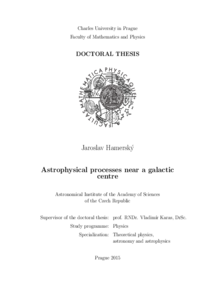Astrophysical processes near a galactic centre
Astrofyzikální procesy v blízkosti jádra galaxie
dizertační práce (OBHÁJENO)

Zobrazit/
Trvalý odkaz
http://hdl.handle.net/20.500.11956/81375Identifikátory
SIS: 110319
Katalog UK: 990020314150106986
Kolekce
- Kvalifikační práce [11342]
Autor
Vedoucí práce
Oponent práce
Kulhánek, Petr
Janiuk, Agnieszka
Fakulta / součást
Matematicko-fyzikální fakulta
Obor
Teoretická fyzika, astronomie a astrofyzika
Katedra / ústav / klinika (externí)
Informace není k dispozici
Datum obhajoby
21. 9. 2015
Nakladatel
Univerzita Karlova, Matematicko-fyzikální fakultaJazyk
Angličtina
Známka
Prospěl/a
Klíčová slova (česky)
Černá díra, akreční disk, obecná relativita, jádro galaxieKlíčová slova (anglicky)
Black hole, accretion torus, general relativity, galactic centreAkreční disk je důležitý astrofyzikální jev, jehož přítomnost je klíčem k vysvětlení mnoha procesů souvisejících s tokem hmoty a uvolňováním energie ve formě záření na různých prostorových škálách, a to jak kolem málo hmotných tak kolem superhmotných černých děr. Pokud je jeho sta- cionární stav perturbován, disk začne oscilovat, a jestliže při tom nějaká část disku přesáhne uzavřenou ekvipotenciální plochu, je tento materiál akreován, nebo urychlen ve formě výtrysku. Tyto oscilace jsou zdrojem informací o časoprostoru a o vnitřní struktuře disku. V této práci se zabýváme studiem oscilačních a akrečních vlastností geometricky tlustých akrečních disků po- mocí obecně relativistických magnetohydrodynamických simulací v axiálně symetrickém 2-D přístupu. Diskutujeme vliv velkorozměrového magnet- ického pole a profilu hustoty momentu hybnosti na oscilace disku a na pohyb akreované hmoty. 1
An accretion torus is an important astrophysical phenomenon which is be- lieved to account for various features of mass inflow and release of radiation on diverse scales near stellar-mass as well as supermassive black holes. When the stationary torus is perturbed it starts to oscillate and once some part of the torus overflows the closed equipotential surface, defined by the stationary solution, this material is accreted or ejected. These oscillations reveal both spacetime properties and the intrinsic characteristics of the torus model. We study the oscillation and accretion properties of geometrically thick accretion tori using general relativistic magnetohydrodynamic simulations. Assuming axial symmetry these simulations are restricted to 2-D approximation. We discuss the impact of the presence of the large scale magnetic field and the profile of the specific angular momentum on the oscillation properties and on the accretion flow motion. 1
